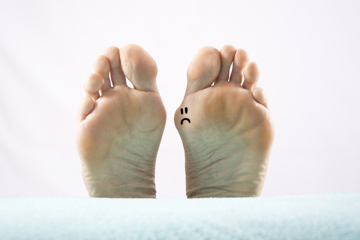
Having Problems with Bunions?
Do you have a bony bump on the joint or base of your large toe? It may be a bunion. A bunion typically occurs when some of the bones in the front part of your foot move out of place. This causes the tip of your big toe to get drawn towards your other toes, which forces the joint or base of your big toe to protrude out. Bunions can cause severe pain and discomfort and can be a real burden to your day, especially if you’re on your feet all day or do a lot of walking.
How to Identify a Bunion
To help you determine if you have a bunion or not, consider these signs and symptoms:
- A protruding bump on the outside of the base of your big toe.
- Pain, redness and swelling around the bump.
- Corns or calluses — these frequently develop where the first and second toes rub against each other.
- Consistent pain or pain that comes in waves.
- Restricted movement of your big toe.
What Causes a Bunion?
Most experts believe that genetics play an important role in the development of bunions. If you have inherited such conditions as: being flat-footed, having excessively flexible ligaments, or having abnormal bone structure, you are much more prone to developing a bunion. These foot conditions allow the muscles in the foot to pull the big toe out of position, ultimately resulting in the formation of a bunion. Therefore, it is imperative to address the muscle imbalance if one wishes to avoid the development of a bunion.
No matter the cause, if a bunion is not treated early in its development , the bunion will worsen over time. The deformity can be accelerated by things such as:
- Wearing shoes that don't fit properly.
- Wearing shoes that have high heels or pointy toes. (It should be noted that not all experts agree that tight shoes cause bunions or if they just worsen an already existing problem).
- Standing or walking for long periods in shoes that do not properly support the foot.
- Having symptoms of arthritis in your feet.
Preventing Bunions
Although genetics can play a major role in bunions, there are a few things you can do to help prevent a bunion from forming or becoming worse. These preventative measures include:
- Switching to a pair of shoes that has more space for your toes.
- Choosing shoes that have soft soles to help take the pressure off of your toes.
- Choosing shoes that have a good arch support in order to stabilize the foot.
- Avoiding high heels and pointy shoes altogether.
Treating Bunions
If left untreated, bunions can lead to more serious issues. Untreated bunions can cause arthritis in your big toe and they can also push your second toe out of place, which is a painful condition that can lead to even more problems with the mechanics of your foot. That’s why treating a bunion right away is so crucial. Treatment options for bunions include:
- A BunionAligner is a convenient method to put gentle traction on the big toe to help straighten it.
- Taking over-the-counter pain relievers such as acetaminophen, ibuprofen, or naproxen to manage pain while you're waiting for or undergoing treatment.
- Having custom orthotics made for you can help stabilize the foot and thereby slow down the formation of a bunion.
- Since flat feet are a major cause of bunion formation, HyProCure surgery can frequently be a solution for bunion correction.
- As a last resort, your chiropodist may recommend a referral to an orthopedic surgeon who will surgically remove part of the bone or remove swollen tissue from the affected joint.
Make an appointment with the dedicated chiropodists at Medical Foot Solutions today if you have a bunion or any other foot condition that is causing you pain or limiting your enjoyment of life.

